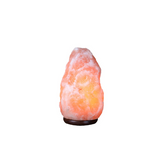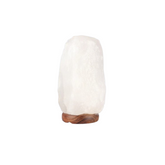Why Does My Himalayan Salt Lamp Sweat? Causes and Fixes
Why Does My Himalayan Salt Lamp Sweat? Causes and Fixes
Himalayan salt lamps are prized for their warm amber glow and their ability to create a calming atmosphere. But many owners encounter a puzzling issue: their lamp starts to “sweat” or leak water. If you’ve noticed droplets of moisture forming on your lamp or small puddles collecting beneath it, don’t worry this isn’t a defect. It’s a natural property of salt at work. In this guide, we’ll explain why Himalayan salt lamps sweat, the science behind it, and practical solutions to keep your lamp looking beautiful while lasting for years.
What Does “Sweating” Mean in a Salt Lamp?
When people say their Himalayan salt lamp is sweating, they’re describing the appearance of condensation or water droplets forming on the lamp’s surface. This happens because salt is hygroscopic it attracts and absorbs moisture from the surrounding air.
In humid environments, the lamp may pull in more water vapor than it can release, leading to visible wetness. This is not a manufacturing flaw but rather an expected result of salt’s natural properties.
Quick definition for featured snippet:
A Himalayan salt lamp “sweats” when it absorbs moisture from humid air due to its hygroscopic nature, causing condensation on its surface.
Why Do Himalayan Salt Lamps Sweat?
The primary cause of sweating is indoor humidity levels. Here’s a breakdown of the main factors:
1. Hygroscopic Properties of Salt
Salt naturally attracts water molecules. This property is why salt clumps in damp kitchens and why your salt lamp may appear wet when placed in a humid room.
2. Climate and Seasonal Changes
- Summer humidity: Lamps sweat more during rainy or humid summer seasons.
- Winter heating: In heated, dry winter rooms, sweating is minimal.
3. Room Placement
- Bathrooms, kitchens, and basements tend to have higher humidity levels, making lamps sweat more.
- Bedrooms or living rooms with moderate airflow tend to keep lamps drier.
4. Lamp Size and Surface Area
A larger lamp with more exposed salt surface will absorb more moisture than a smaller, polished one.
Is Sweating Harmful to the Lamp?
Sweating isn’t harmful to the salt itself it’s a natural process. However, if left unmanaged, excess moisture can:
- Damage wooden furniture or surfaces beneath the lamp.
- Cause metal lamp fittings to corrode.
- Create salt residue rings when the water evaporates.
With proper care, you can prevent these issues and keep your lamp safe.
How to Fix a Sweating Himalayan Salt Lamp
Here are proven methods to manage and reduce sweating:
1. Keep the Lamp On
The heat from the bulb dries the salt, reducing moisture buildup. Aim to keep your lamp lit for at least 8–10 hours daily.
2. Choose the Right Location
- Avoid humid rooms like bathrooms.
- Place lamps in living rooms, bedrooms, or offices where air circulation is better.
3. Use a Protective Base
Set the lamp on a ceramic plate, coaster, or wooden tray to catch any water droplets and prevent furniture damage.
4. Wipe with a Dry Cloth
If sweating occurs, gently wipe the lamp with a soft, dry cloth to remove moisture without scratching the surface.
5. Control Indoor Humidity
- Use a dehumidifier in damp rooms.
- Keep windows open during dry weather to improve airflow.
6. Proper Storage
If you need to store your lamp for a season, wrap it in plastic or a sealed bag to protect it from moisture absorption.
Read more for Himalayan Salt Lamp Care and Maintenance Tips
Common Myths About Salt Lamp Sweating
There are several misconceptions about sweating lamps:
-
Myth: Sweating means the lamp is fake.
-
Truth: Genuine Himalayan salt lamps sweat because real salt absorbs moisture. Fake lamps (often made of resin or plastic) usually do not.
-
-
Myth: Sweating ruins the lamp permanently.
-
Truth: Sweating is reversible. With proper care, the lamp can last for many years.
-
-
Myth: Adding chemicals can prevent sweating.
-
Truth: Never coat your lamp with chemicals or sealants—they block the salt’s natural properties and reduce its effectiveness.
-
Troubleshooting Guide
| Problem | Likely Cause | Quick Fix |
|---|---|---|
| Lamp puddling water | High humidity + lamp off | Keep lamp on, place on tray |
| White salt residue on table | Evaporation after sweating | Use a coaster or wipe regularly |
| Lamp sweating excessively | Placement in kitchen/bathroom | Move to drier room |
| Surface corrosion of metal parts | Excess condensation | Dry lamp, replace fittings if needed |
Care and Maintenance Tips
To ensure your salt lamp lasts:
- Daily check: Quickly wipe moisture if present.
- Weekly care: Inspect bulb and cord for corrosion.
- Seasonal adjustment: Run a dehumidifier in summer.
- Backup protection: Place a microfiber cloth under the lamp in extra-humid conditions.
Final Thoughts
If your Himalayan salt lamp sweats, it’s not a defect but a sign of real salt reacting to humidity in the environment. By keeping the lamp warm, wiping it regularly, and placing it in the right location, you can easily manage sweating while still enjoying its soothing glow. With proper care and maintenance, your lamp will remain a calming and decorative feature in your home for many years.





